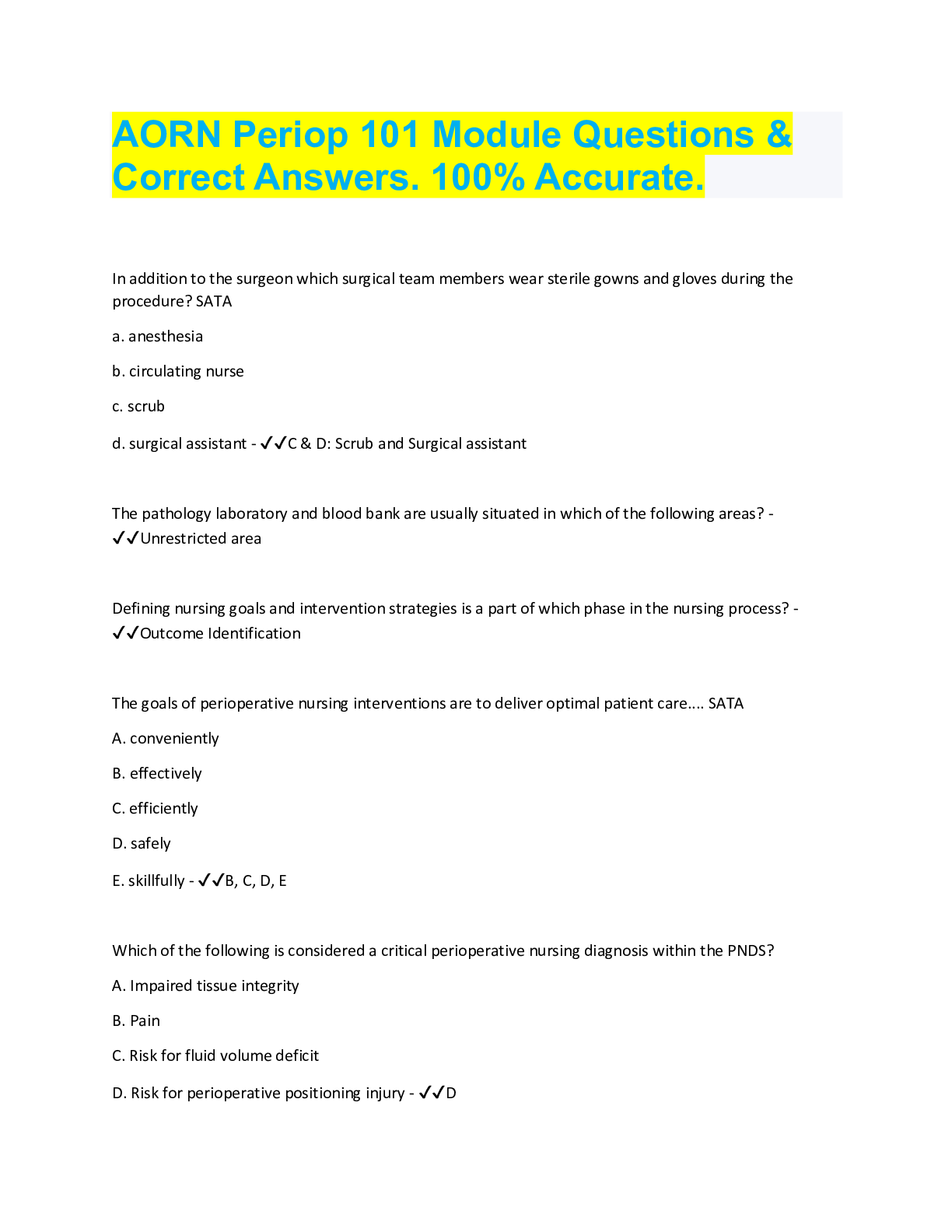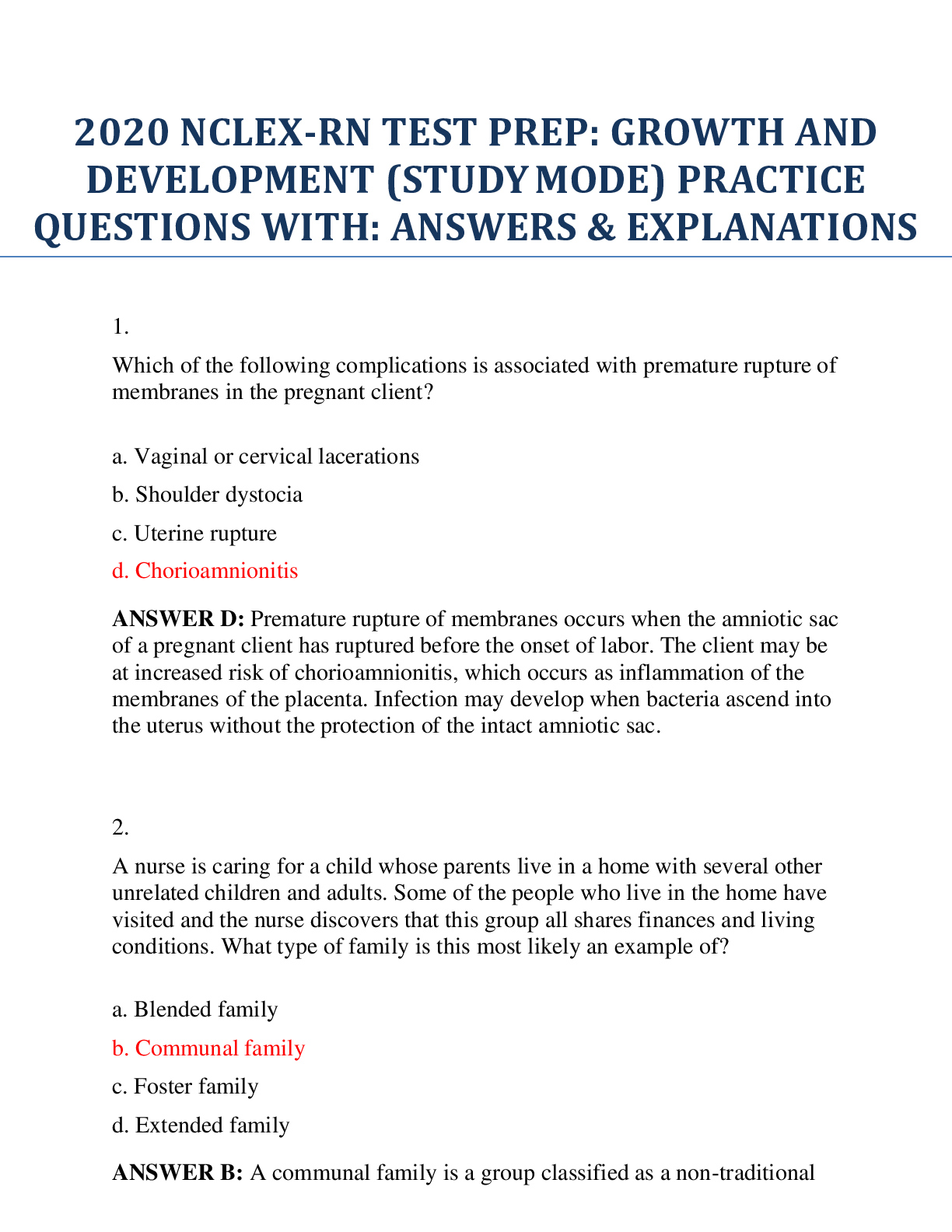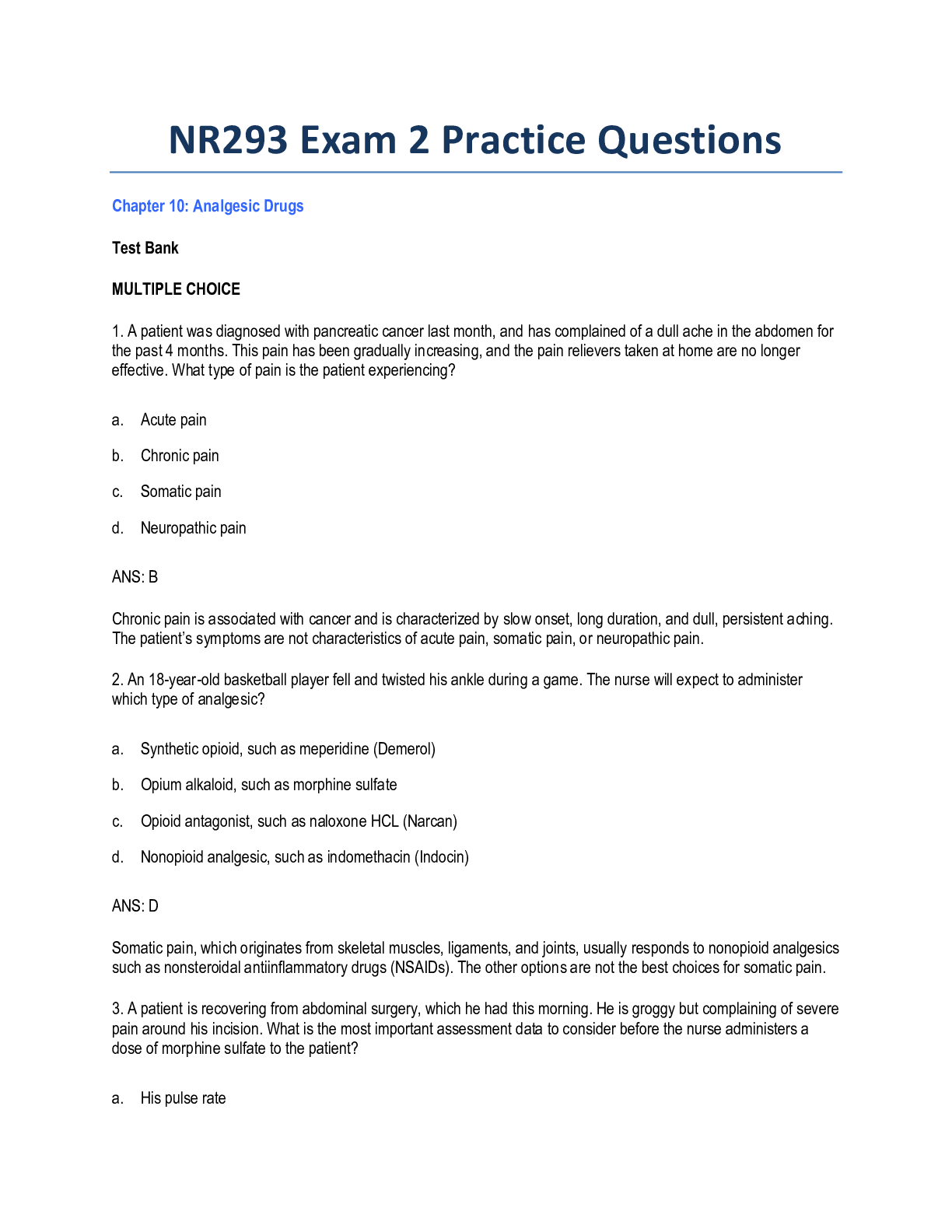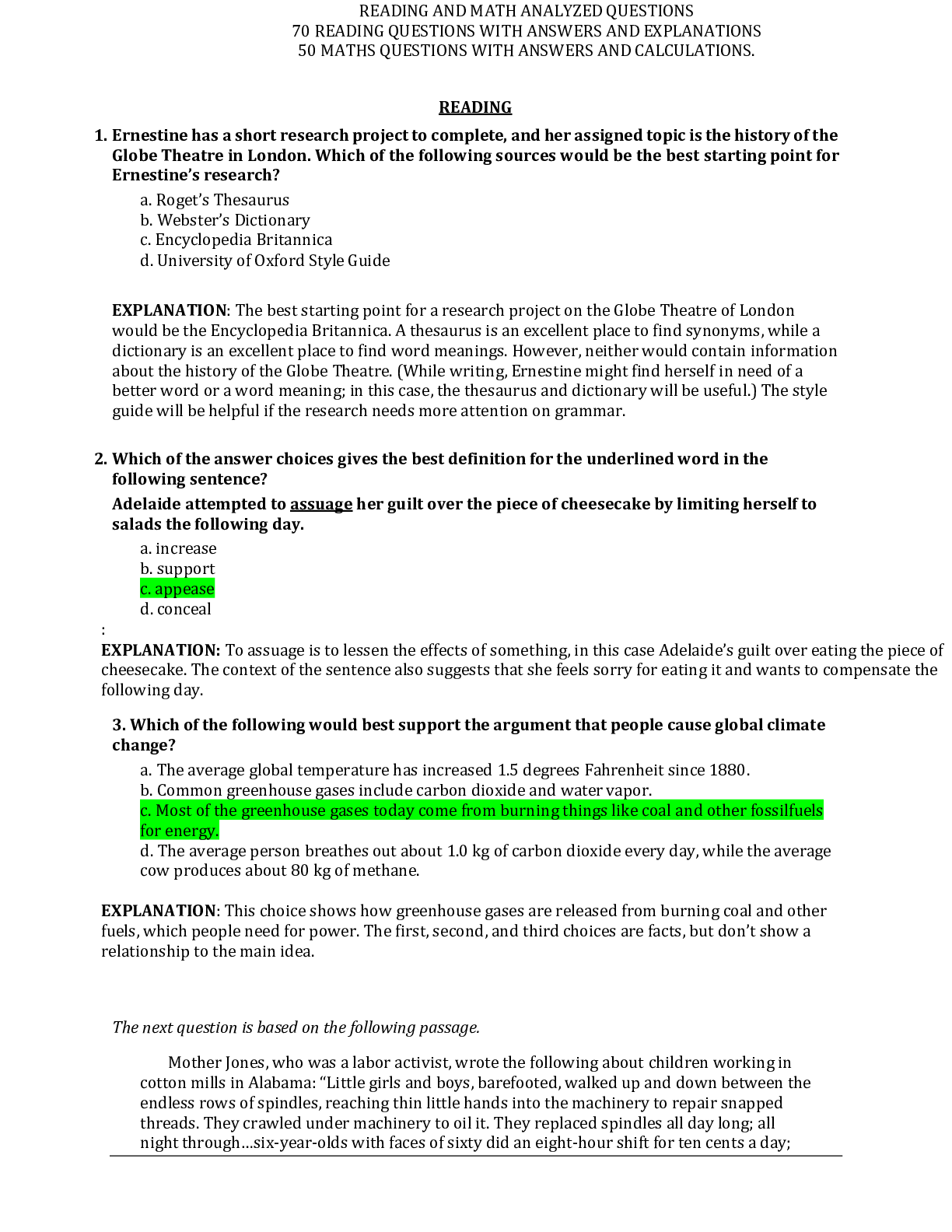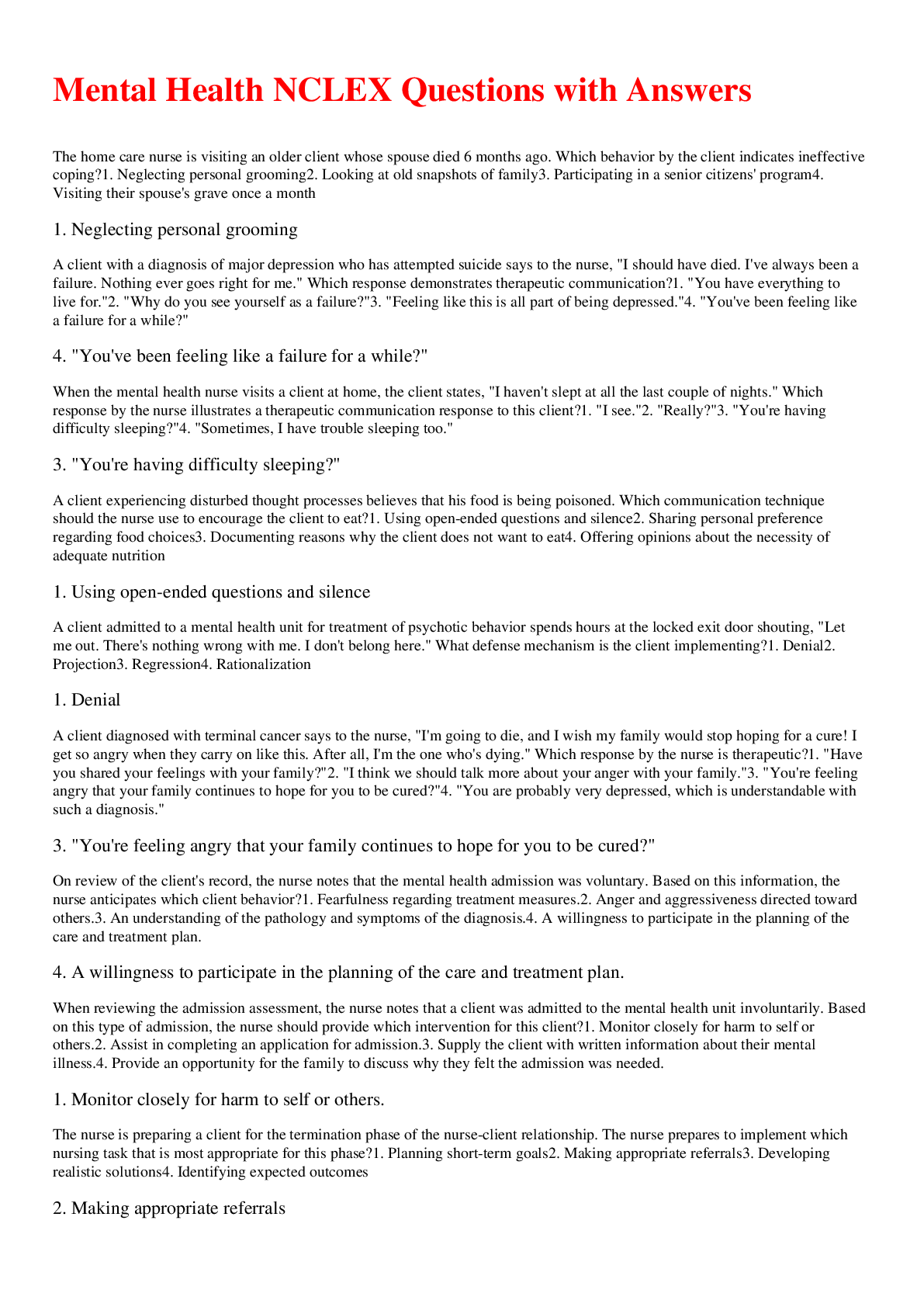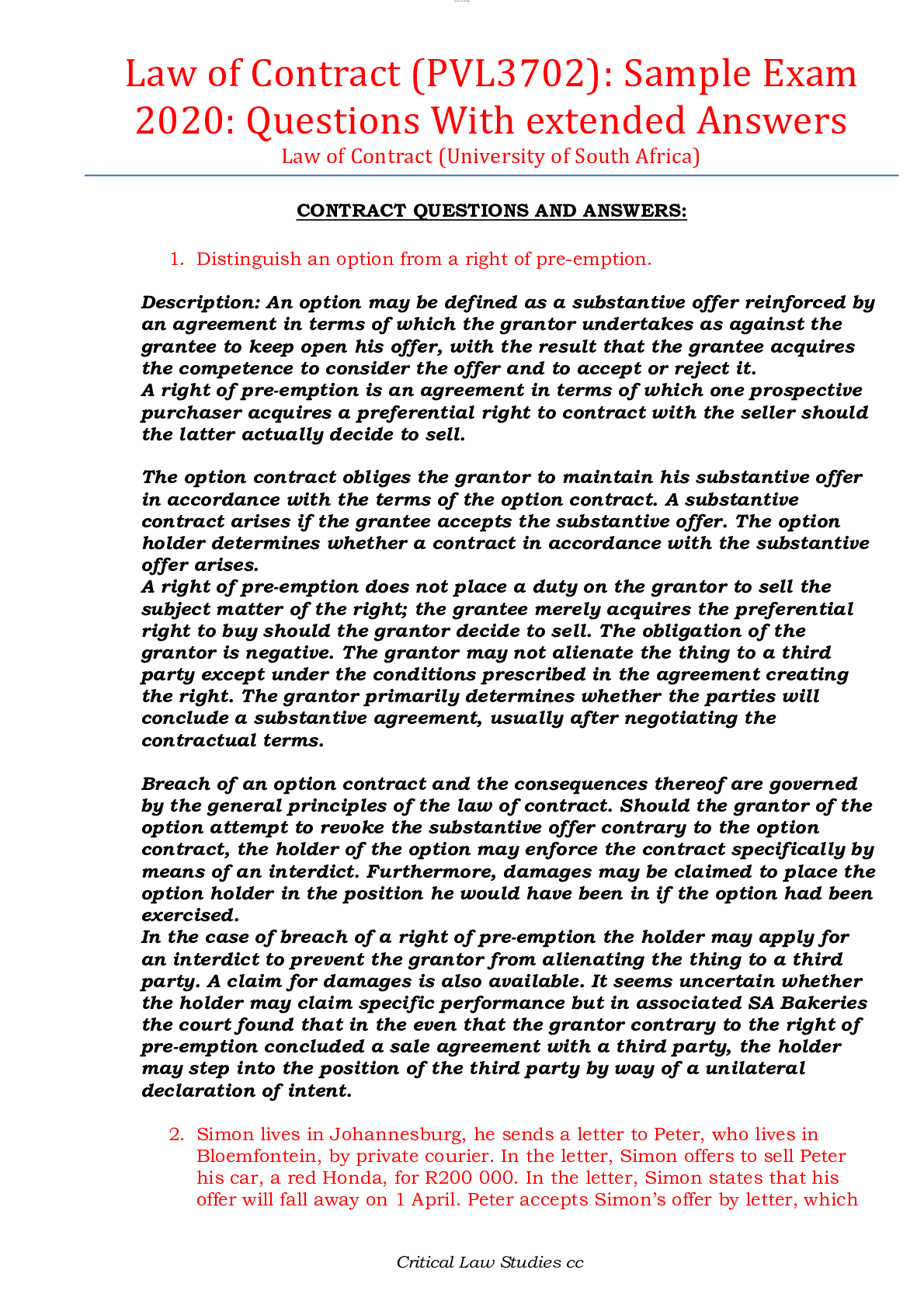Counseling > QUESTIONS & ANSWERS > NCE/CPCE test bank Top Exam Questions with accurate answers, 100% Accurate, rated A+ (All)
NCE/CPCE test bank Top Exam Questions with accurate answers, 100% Accurate, rated A+
Document Content and Description Below
NCE/CPCE test bank Top Exam Questions with accurate answers, 100% Accurate, rated A+ What are Freudian's five stages of psychosexual theory? - Oral, anal, phallic, latency, genital What are id, ... ego, and superego? - Id--pleasure principle: irrational, illogical, only concerned with the bodily drives Ego--reality principle: rational, logical, utilizes the power of reasoning and control Superego--concerned with the moralistic and idealistic portion of the personality What are Jean Piaget's 4 stages of cognitive development? - Sensorimotor, preoperational, concrete operational, formal operational The only psychoanalyst who created a developmental theory which encompasses the entire life span was a. Erik Erikson b. Milton H. Erickson c. A.A. Brill d. Jean Piaget - a Milton Erickson--brief psychotherapy and hypnosis A.A. Brill--career theory Jean Piaget's four stages of cognitive development theory is for children Sensorimotor stage - 1-2 Use senses to explore the world Preoperational stage - 2-7 Egocentrism, play pretend (mental representation for objects), inquisitiveness Concrete operational stage - 7-11 Reversibility--things that are altered can be brought back to its original state Conservation Formal operational stage - 12-18 Abstract thinking Jay Haley - Strategic and problem-solving therapy--use the technique of paradox Arnold Lazarus - Multimodal therapy (BASIC ID--behavior, affect, sensation, imagery, cognition, interpersonal factors, drug/biological considerations) Robert Perry - Adult/college students' cognitive development transition from dualistic thinking (right or wrong) to relativistic thinking Robert Kegan - Constructive Development Theory--individuals construct reality throughout the life span The first intelligence test was created by - Alfred Binet Who coined the term behaviorism in 1912? - John Watson--Little Albert experiment _____ expanded on Piaget's conceptualization of moral development. a. Erik Erikson b. Lev Vygotsky c. Lawrence Kohlberg d. John B. Watson - c. Kohlberg--lead theorist in moral development; used stories to determine the moral development in children What are the stages of Lawrence Kohlberg's moral development? - Preconventional morality--when the child is responsive to cultural norms -stage 1: obedience and punishment orientation--physical consequences determines goodness vs badness -stage 2: instrumental-relativistic orientation--reciprocity and equal sharing Conventional morality--focuses on maintaining the expectations of families and groups -stage 3: interpersonal concordance--good behavior motivated by approval by others -stage 4: law & order orientation--orientation towards authority and rules Postconventional morality -stage 5: social contract and legalistic orientation-- -stage 6: universal principles--common good of the society What are some key principles of individual psychology? - -Early interactions with family, peers and adults determine the role of inferiority and superiority in life. -Birth order has an impact of a child's personality and feeling of inferiority. -All human behavior is goal oriented and motivated by striving for superiority. -A natural reaction to inferiority is compensation. -If a person is unable to compensate for normal feelings of inferiority, they develop an inferiority complex. -The overarching goal of Adlerian psychotherapy is to help the patient overcome feelings of inferiority. Founder of individual psychology - Alfred Adler Positive psychology is coined by ____ and popularized by ____ - Abraham Maslow, Martin Seligman What are the stages of interpersonal development developed by Harry Stack Sullivan? - Infancy (0-18 months)--oral gratification Childhood (18 months-6 y)--delayed gratification Juvenile (6-9)--forming peer relationships Pre adolescence (9-12)--same-sex relationships Early adolescence (12-14)--opposite-sex relationships Late adolescence (14-21)--self-identity is developed Counterconditioning - A behavioristic technique in which the goal is to weaken or eliminate a learned response by pairing it with a stronger or desirable response. Fugue state - when an individual experiences memory loss and leaves home, often with the intention of changing their job and identity DBT was created by - Marsha M Linehan Freud and Erikson a. could be classified as behaviorists b. could be classified as maturationists c. agreed that developmental stages are psychosexual d. were prime movers in the DBT movement - b. The concept of maturation hypothesis (or maturation theory) suggests that behavior is guided exclusively via hereditary factors, but that certain behaviors will not manifest themselves until the necessary stimuli are present in the environment. It also suggests that the individual's neural development must be at a certain level of maturity for the behavior to unfold. A counselor who believes in this concept strives to unleash inborn abilities, instincts, and drives What are Daniel Levinson's stages of adult development? - Pre-adulthood (conception-22): individual moves from high dependence to high independence Early adulthood (22-45): high energy and high stress; pursues life passions and career and family goals Middle adulthood (40-65): high responsibility Late adulthood (65+): individual reflects on his life and accomplishment The researcher who is well known for his work with maternal deprivation and isolation in rhesus monkeys is a. Harry Harlow b. John Bowlby c. Lawrence Kohlberg d. all of the above - a. Harlow believed that attachment was an innate tendency and not one which is learned. His experiments with baby monkeys showed that they prefer a terry-cloth surrogate mother than a wire surrogate mother, even thought the latter provides milk. Monkeys placed in isolation developed autistic abnormal behaviors. Evidence that this is true in man comes from the work of Rene Spitz, who noted that children reared in impersonal institutions (and hence experienced maternal deprivation between the 6th and 8th months of life) cried more, experienced difficulty sleeping, and had more health-related difficulties. Spitz called this "anaclitic depression". These infants would ultimately experience great difficulty forming close relationships. According to Freud's dream analysis theory, what are the two types of dream content? - Manifest content and latent content Manifest content: the actual dream material as it is presented to the dreamer Latent content: the hidden meaning of the dream What are Freud's two fundamental drives according to his book, Beyond the Pleasure Principle? - Eros and thanatos Eros: the life instinct--the drive of life, love, creativity, sexuality, self satisfaction and species preservation Thanatos: the death instinct--the drive of aggression, sadism, destruction, violence and death In adolescence a. females commit suicide more than males b. suicide is a concern but statistically very rare c. the teens who talk about suicide are not serious d. males commit suicide more often than females, but females attempt suicide more often - d. Males commit suicide more often than females in all age brackets. One theory is that males are more successful in killing themselves because they use firearms whereas females rely on less lethal methods. Suicide is generally the tenth leading cause of death in the U.S. as well as the second leading killer of teens. In the general U.S. population a. the suicide rate is 2/100,000 b. suicide occurs at the beginning of a depressive episode, but rarely after the depression lifts c. suicide rates tend to increase with age d. suicide occurs at the beginning of a depressive episode, but rarely after the depression lifts, and suicide rates tend to increase with age - c. Suicide clients often make attempts after the depression begins to lift, due to the regain of energy level and the remaining of hopelessness. The overall suicide rate in the U.S. is about 12/100,000. When comparing girls to boys, it could be noted that, in general a. girls grow up to smile more b. girls are using more feeling words by age 2 c. girls are better able to read people without verbal cues at any age d. all of the above - d. Boys on the other hand, are more physically active and aggressive. Development a. begins at birth b. begins during the first trimester of pregnancy c. is a continuous process which begins at conception d. a and c - c. Developmental psychologists are fond of looking at prenatal influences (i.e. smoking or alcohol consumption) that affect the fetus before birth. Freud's Oedipus complex (or Oedipus stage) a. is the stage in which fantasies of sexual relations with the opposite-sex parent occur b. occurs during the phallic stage c. a and b d. is a concept Freud ultimately eliminated from his theory - c. The Oedipus complex refers to the boy's secret wish to marry his mother, paired with rage toward his father--is said to occur between ages 3 and 5 (phallic stage). Oedipus originated from the Greek myth in which Oedipus, the mythical king of Thebes, unknowingly killed his father and married his mother. In girls the Oedipus complex may be referred to as - The Electra complex. During this stage, the child is said to have a fantasy in which he or she wishes to kill the parent of the opposite sex. Freud went on to hypothesize that eventually the child identifies with the parent of the same sex, which leads to internalization of parental values, and thus the conscience or superego is born. Libido refers to - sexual desire or impulse Eleanor Gibson researched the matter of depth perception in children by utilizing a. Piaget's concept of conservation b. Erikson's trust versus mistrust paradigm c. Piaget's formal operations d. an apparatus known as a visual cliff - d. The experiment used 6 months old infants (as soon as they can crawl) to see if they would cross a glass drop-off to reach their moms on the other side. The experiment is sequenced by animals that are mobile as soon as they are born. The two experiments demonstrated that depth perception is an innate skill in infants and animals. Theorists who believe that development merely consists of quantitative changes are referred to as a. organismic theorists b. statistical developmentalists c. empiricists d. all of the above - c. Empiricism grew out of the philosophy of John Locke in the 1600s and is sometimes referred to as associationism. According to this theory, scientists can learn only from objective facts. An organismic viewpoint is slanted toward qualitative rather than quantitative factors that can be measured empirically. Organismic psychologists do not believe in a mind-body distinction, as they see all organs as an integrated system. The term organismic also has been used to describe gestalt psychologists, such as Kurt Goldstein, who emphasize a holistic model. Since empiricists believe developmental changes can be measured and the organicists feel that change can be internal, the two views are sometimes said to be opposing viewpoints. A major distinction between an organismic theorist and an empiricist is that the former emphasizes the role of innate abilities in developing knowledge, while the latter stresses the importance of sensory experience in the development of knowledge. An empiricist view of development would be a. psychometric b. behavioristic c. against the use of formal statistical testing d. a and c - b. Empiricism is considered an antecedent to behaviorism. Behaviorists claim that "if you can't measure it then it doesn't exist". Behavioristic empiricist researchers value statistical studies and emphasize the role of the environment. A mother hides a toy behind her back and a young child does not believe the toy exists anymore. The child has not mastered a. object permanence b. reflexive response c. representational thought d. a and c - d. The child who has not mastered object permanence is still victim of "out of sight, out of mind". The child needs representational thought (i.e. the use of symbols or languages to represent events) to master object permanence. During this initial stage, the child learns the concept of time (i.e. that one event takes place before the other), and causality (i.e. that a hand can move an object). The schema of permanency and constancy of objects occurs in the a. sensorimotor stage--birth to 2 years b. preoperational stage--ages 2-7 years c. concrete operational stage--ages 7-12 years d. formal operational stage--12 years and beyond - a. A counselor who utilizes the term instinctual technically means a. behavior results from unconscious aggression b. women will show the behavior to a higher degree than men c. a and b d. behavior that manifests itself in all normal members of a given species - d. Instincts (eg. hunger) are species-specific innate behaviors that do not need to be practiced or learned. Instincts are not learned behavioral responses. The word ethology, which is often associated with the work of Konrad Lorenz, refers to - The study of animals' behavior in their natural environment The term comparative psychology refers to laboratory research using animals and attempts to generalize the findings to humans. Konrad Lorenz is best known for his work on the process of imprinting; this illustrates the principle of "critical periods", which states that certain behaviors must be learned at an early time in the animal or a person's development. A child who focuses exclusively on a clown's red nose but ignores the clown's other features would be illustrating the Piagetian concept of a. egocentrism b. centration c. formal abstract reasoning d. deductive processes - b. Centration occurs in the preoperational stage and is characterized by focusing on a key feature of a given object or situation while not noticing the rest of it. Egocentrism refers to the preoperational child's inability to see the world from anyone else's vantage point. Deductive thinking processes allow an individual to apply general reasoning to specific situations. The acquisition of a symbolic schema occurs in which stage of Piaget's cognitive development? - Preoperational (ages 2-7) Symbolic mental processes allow language and symbolism in play to occur--a milk carton can become a spaceship or a pie plate can become the steering wheel of a car What are Robert Havinghurst's developmental task stages? - Infancy and early childhood: learning to walk and eat solid food Middle childhood (6-12): learning to get along with peers or developing a conscience Adolescence (12-18): preparing for marriage and an economic career Early adulthood (19-30): selecting a mate and starting a family Middle age (30-60): assisting teenage children to become responsible adults and developing leisure-time activities Later maturity (61+): dealing with the death of a spouse and adjusting to retirement This psychoanalytic concept suggests that a young child witnesses his parents having sexual intercourse or is seduced by a parent, in which this real or imagine incident is said to provide impetus for later neuroses. - primal scene What are the three consciousness levels according to Freud? - Conscious level consists of all those things we are aware of, including things we know about ourselves and things we know about our surroundings. Preconscious consists of those things we could pay conscious attention to if we so desired, and where many memories are stored for easy retrieval. Preconscious are thoughts that are unconscious at a particular moment, but that are not repressed and are therefore available for recall and easily capable of becoming conscious (the "tip of the tongue" effect). Unconscious consists of those things that are outside of conscious awareness, including many memories, thoughts, and urges of which we are not aware. Much of what is stored in the unconscious is thought to be unpleasant or conflicting, yet they are thoughts that influence our behavior. What are Jung's concepts of anima and animus? - Originating in the idea that anima/animus archetype is a counterpart of gender identity, the images are traditionally considered as feminine for men and masculine for women. Anima is usually related to the emotional, empathetic, and sensitive aspects, while animus is usually related to the active, intellectual, exploring side of the personality. According to the Yale research by Daniel J. Levinson a. Erikson's generativity versus stagnation stage simply doesn't exist b. 80% of the men in the study experienced moderate to severe midlife crises c. an "age 30 crisis" occurs in men when they feel it will soon be too late to make later changes d. b and c - d. Systematic desensitization was developed by - Joseph Wolpe Who developed rational-emotive behavior therapy (REBT), which teaches clients to think in a more scientific and logical manner? - Albert Ellis Risky shift phenomenon - Risky shift phenomenon describes the fact that a group decision is typically more liberal (less conservative) than the average decision of a group member prior to participation in the group. Which theorist is most likely to say that aggression is an inborn tendency? a. Carl Rogers b. B. F. Skinner c. Frank Parsons d. Konrad Lorenz - d. According to Lorenz, aggressiveness is part of our evolution and was necessary for survival. The solution according to Lorenz is for us to utilize catharsis and get our anger out, using methods such as competitive sports. Piaget is a. a maturationist b. a behaviorist c. a structuralist who believes stage changes are qualitative d. cognitive-behavioral - c. Jean Piaget wrote a book called Structuralism. Cognitive-behavioral generally implies to counselors who emphasize thought processes in terms of their impact on emotions as well as behavioristic strategies (eg, reinforcement or homework assignments). Phenylketonuria (PKU) - A genetic inability to metabolize phenylalanine that causes intellectual or physical disabilities unless the baby is put on a special diet. Klinefelter's Syndrome - When a male has an extra X chromosome and results in a high-pitched voice, an IQ 10 points below the norm, shows no masculinity at puberty and may be infertile Turner's syndrome - A condition in female that results in missing or partially missing the X chromosome, as well as no gonads or sex hormones and is unable to have children. Hemophilia - A genetic condition that a person's blood-clotting ability is severely reduced and a tiny injury can cause severe bleeding. Sickle cell anemia - A genetic disease that causes the shape of blood cells into sickle shape, and can block normal blood flow. This condition can cause pain, anemia, reduced life span and organ damage. A condition in which a person wishes to eat items that are not food, such as consuming a pencil or a watch band. - Pica A historical term today known as somatization disorder, in which occurs when an individual displays an organic symptoms (such as blindness, paralysis etc.) yet no physiological causes are evident. - Hysteria Cultural relativism - It connotes that a behavior cannot be assessed as good or bad except within the context of a given culture. The meaning of desirability of a given behavior, trait, or act is based on the culture. _____ helped to popularize the multicultural counseling movement. a. Arthur Jensen's views on IQ testing (aka. Jensenism) b. The civil rights movement c. Jung's feeling that all men and women from all cultures possess a collective unconscious d. The Tarasoff duty - b. Jensen tried to prove that African Americans had lower IQs due to genetic factors. The Tarasoff case resulted in the counselor's duty to warn and protect an intended victim who might be the target of danger or violence. When a counselor speaks of what he or she believes must transpire from a psychotherapeutic standpoint, he or she technically is referring t [Show More]
Last updated: 1 year ago
Preview 1 out of 68 pages
Instant download

Buy this document to get the full access instantly
Instant Download Access after purchase
Add to cartInstant download
Also available in bundle (1)

CPCE/NCE Exam BUNDLE, QUESTIONS AND ANSWERS, VERIFIED.
CPCE/NCE Exam Prep, question sections coverage, graded A+, latest update. ALL 34 VERSIONS. PASS YOUR EXAMS WITH THIS BUNDLE. 47 VERSIONS
By Topmark 1 year ago
$38
34
Reviews( 0 )
Document information
Connected school, study & course
About the document
Uploaded On
Mar 12, 2023
Number of pages
68
Written in
Additional information
This document has been written for:
Uploaded
Mar 12, 2023
Downloads
0
Views
87






